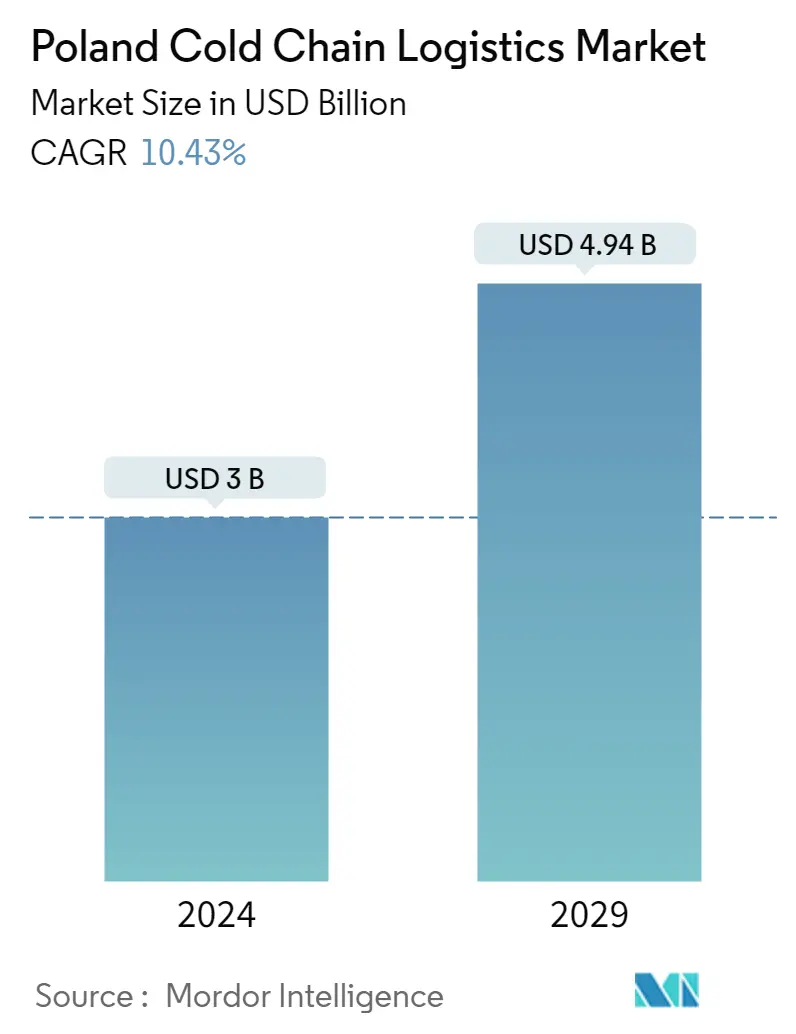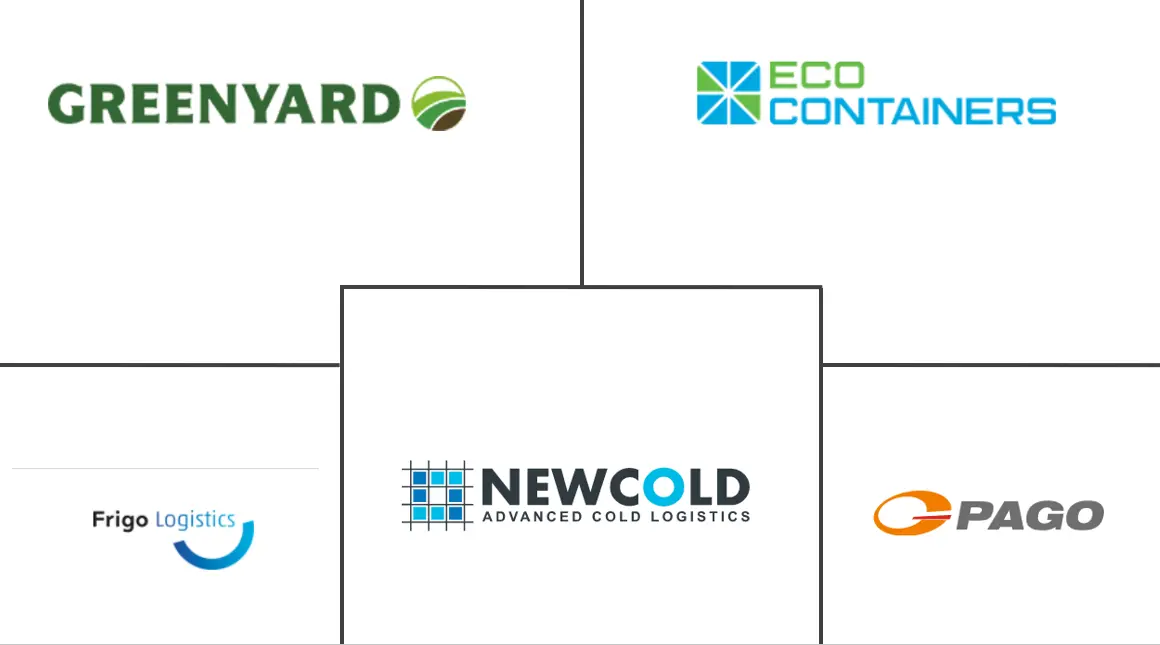Market Size of Poland Cold Chain Logistics Industry

| Study Period | 2020 - 2029 |
| Base Year For Estimation | 2023 |
| Market Size (2024) | USD 3.00 Billion |
| Market Size (2029) | USD 4.94 Billion |
| CAGR (2024 - 2029) | 10.43 % |
| Market Concentration | Medium |
Major Players
*Disclaimer: Major Players sorted in no particular order |
Poland Cold Chain Logistics Market Analysis
The Poland Cold Chain Logistics Market size is estimated at USD 3 billion in 2024, and is expected to reach USD 4.94 billion by 2029, growing at a CAGR of 10.43% during the forecast period (2024-2029).
Poland is one of the leading agri-food producers and one of Europe’s largest producers. As the second-largest country in Central Europe, Poland is an attractive market for all kinds of food professionals, opening up a huge potential for the cold chain logistics industry.
The two major transport corridors connecting Poland to Northern Europe and Central Asia make it a regional food hub, extending beyond the European Union’s borders to the Mediterranean, North Africa, and Asia. The country’s favorable location makes it fully accessible to the well-served road, air, and rail links.
The energy crisis caused by the Russian invasion of Ukraine has caused households and businesses to brace themselves for an unprecedented winter of energy prices. Many businesses, not least those in the cold chain industries, are already struggling with these rising costs.
With an annual investment of around USD 2 billion in new warehouses, storage capacity is set to increase significantly in the coming years. In addition, several factors are increasing the demand for transportation solutions in Poland, such as food, nuclear power plants, and temperature-sensitive machinery and equipment. GLP, one of the investors and logistics warehouse and distribution park builders, launched two new logistics facilities in Poland on 31 March 2022. This project was part of GLP’s ongoing work in Poland. In total, GLP expects to deliver about 240,000 sq.m worth of logistics projects in the country in 2022.
Food exports are an important part of Poland's multi-billion-dollar economy. As a result, Polish exporters are constantly looking for top-notch cold chain logistics solutions, including reefer trucks, chiller equipment, and warehousing facilities.
Imports and exports of fresh, chilled, or frozen produce are a constant worry for Poland. Every year, millions of tonnes of food and beverage goods, which require refrigerated transportation, enter and leave the country.
Food exports play an important role in Poland’s multibillion-dollar economy. The country’s central European location makes it a regional food hub, with the potential to expand its reach beyond the European Union and into the Mediterranean, North African, and Asian markets. As a result, Polish companies must deliver their products intact, ready to be processed or consumed, to overseas markets.
Poland Cold Chain Logistics Industry Segmentation
Cold chain logistics refers to the technology and process used to ensure the safe shipment of temperature-sensitive goods and items throughout the supply chain. Almost any perishable product or branded product would almost certainly fall into the cold chain management category. Examples of perishable products include meat and fish, produce, medical supplies, and pharmaceuticals.
A comprehensive background analysis of the Polish Cold Chain Logistics Market covering the current market trends, restraints, technological updates, and detailed information on various segments and the competitive landscape of the industry. The impact of COVID-19 has also been incorporated and considered during the study. The report offers market size and forecasts for the Bahrain co-working office space market in value (USD) for all the above segments.
The Polish cold chain logistics market is segmented by service (storage, transportation, and value-added services), by temperature type (chilled, frozen, and ambient), and by end user (horticulture, dairy products, meats, fish, poultry, processed food products, pharma, life sciences, and chemicals, and other applications).
| By Service | |
| Storage | |
| Transportation | |
| Value-added Services (Blast Freezing, Labeling, Inventory Management, etc.) |
| By Temperature | |
| Chilled | |
| Frozen | |
| Ambient |
| By End User | |
| Horticulture (Fresh Fruits & Vegetables) | |
| Dairy Products (Milk, Ice-cream, Butter, etc.) | |
| Meats, Fish, Poultry | |
| Processed Food Products | |
| Pharma, Life Sciences, and Chemicals | |
| Other End Users |
Poland Cold Chain Logistics Market Size Summary
The cold chain logistics market in Poland is poised for significant growth, driven by the country's strategic position as a leading agri-food producer in Europe. Poland's central location in Europe, coupled with its robust transport corridors connecting to Northern Europe and Central Asia, positions it as a regional food hub. This accessibility to well-developed road, air, and rail links enhances the potential for cold chain logistics, which is crucial for maintaining the quality and safety of temperature-sensitive goods. The market is experiencing increased demand due to the need for efficient transportation solutions for food exports, nuclear power plants, and temperature-sensitive machinery. The ongoing energy crisis, exacerbated by geopolitical tensions, has posed challenges, but substantial investments in new warehouses and storage facilities are expected to bolster the market's capacity.
Poland's cold chain logistics sector is characterized by a mix of international and domestic players, with companies like Green Yard Logistics, Pago Logistics, Frigo Logistics, New Cold Logistics, and Eco Containers leading the market. The demand for refrigerated transport is driven by the need to maintain the integrity of food products during import and export processes, particularly for meat, fish, and dairy products, which require strict temperature controls. The market is recovering positively post-pandemic, with new developments such as NewCold's temperature-controlled warehouse in Nowy Modlin and Maersk's Container Protect Essential product enhancing the logistics infrastructure. As Poland continues to expand its reach beyond the European Union into Mediterranean, North African, and Asian markets, the cold chain logistics industry is set to play a pivotal role in supporting the country's economic growth and trade ambitions.
Poland Cold Chain Logistics Market Size - Table of Contents
-
1. MARKET INSIGHTS
-
1.1 Current Market Scenario
-
1.2 Market Dynamics
-
1.2.1 Drivers
-
1.2.1.1 Rise In Agriculture Sector and Food Industry
-
1.2.1.2 Rise In Pharmaceutical Industry
-
-
1.2.2 Restraints
-
1.2.2.1 Cost Constraints
-
1.2.2.2 Infrastructure Accessibility
-
-
1.2.3 Opportunities
-
1.2.3.1 Technology Adoption
-
-
-
1.3 Technological Trends and Automation
-
1.4 Government Regulations and Initiatives
-
1.5 Industry Value Chain/Supply Chain Analysis
-
1.6 Spotlight on Ambient/Temperature-controlled Storage
-
1.7 Industry Attractiveness - Porter's Five Forces Analysis
-
1.8 Impact of Emission Standards and Regulations on Cold Chain Industry
-
1.9 Impact of Covid-19 on the Market
-
-
2. MARKET SEGMENTATION
-
2.1 By Service
-
2.1.1 Storage
-
2.1.2 Transportation
-
2.1.3 Value-added Services (Blast Freezing, Labeling, Inventory Management, etc.)
-
-
2.2 By Temperature
-
2.2.1 Chilled
-
2.2.2 Frozen
-
2.2.3 Ambient
-
-
2.3 By End User
-
2.3.1 Horticulture (Fresh Fruits & Vegetables)
-
2.3.2 Dairy Products (Milk, Ice-cream, Butter, etc.)
-
2.3.3 Meats, Fish, Poultry
-
2.3.4 Processed Food Products
-
2.3.5 Pharma, Life Sciences, and Chemicals
-
2.3.6 Other End Users
-
-
Poland Cold Chain Logistics Market Size FAQs
How big is the Poland Cold Chain Logistics Market?
The Poland Cold Chain Logistics Market size is expected to reach USD 3.00 billion in 2024 and grow at a CAGR of 10.43% to reach USD 4.94 billion by 2029.
What is the current Poland Cold Chain Logistics Market size?
In 2024, the Poland Cold Chain Logistics Market size is expected to reach USD 3.00 billion.

